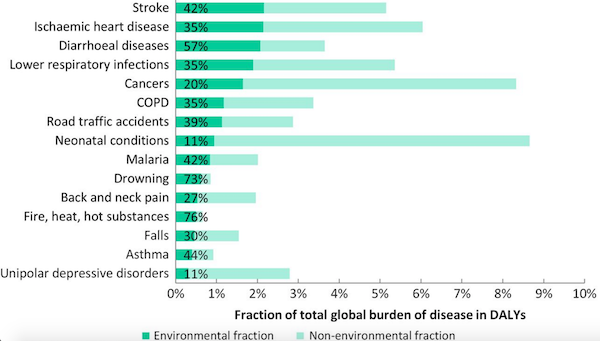Human sovereignty over the environment is a double-edged sword. For instance, on the one hand, advances in science and technology have caused deaths from infectious diseases to plummet around the world. But on the other hand, some pollution has been linked to chronic diseases that erode both our health and life spans. Reducing exposure to noxious environmental factors is a major goal of global public health. But there is some confusion over what "environmental" means in other countries.
A team of international researchers, in collaboration with the World Health Organization, recently attempted to assess the share of the global disease burden directly attributable to environmental risks. Their findings were published in the Journal of Public Health.
First, the authors identified what they considered to be an environmental risk (emphasis added):
Included under environment for the purpose of this study are exposure to pollution and chemicals (e.g. air, water, soil, products), physical exposures (e.g. noise, radiation), the built environment (e.g. housing, land-use, infrastructure), other anthropogenic changes (e.g. climate change, vector breeding places), related behaviours and the work environment. Excluded are life style factors and behaviours which have no or only minor relations with the physical environment such as diet, tobacco or alcohol consumption, environments which cannot reasonably be modified (e.g. wetlands, pollen), or social conditions and unemployment.
Using those broad criteria, the authors combined a systematic literature review with other less empirical data (such as disease transmission pathways but also opinions) to create causation with 133 different diseases and injuries in 2012. In the figure below, major causes of death and disability are shown, along with the fraction they say are attributable to their notion of environmental causes.

Overall, about 56 million people died in 2012. Of these, the authors estimate that 12.6 million people (23%) met their demise prematurely due to what they call environmental risks. For example, 42% and 35% of strokes and ischemic heart disease, respectively, were linked to indoor/outdoor air pollution, lead exposure, work-related stress, and the like. (Remember, lifestyle factors such as diet and smoking are not considered "environmental.") Similarly, 20% of cancers they correlated to pollution, ionizing radiation, and exposure to "chemicals," though they didn't specify which ones. (Click here for a table showing diseases and their associated environmental risks.)
The 12.6 million* environmentally-caused deaths broke down as follows:
8.2 million: Noncommunicable disease
2.5 million: Infectious, parasitic, neonatal, and nutritional disease
2.0 million: Injuries
From a public health strategy standpoint, the deaths from infection and lack of proper nutrition probably would be the "easiest" to address. It is certainly simpler to provide good food and medicine to people (which can occur on a timescale of months or years) than it is to build sewage systems or clean up the environment (which can take years or even decades).
Clearly, the limitation to a study like this is that it relies heavily upon estimates and extrapolation and perhaps selection bias in the definition of environmental, and in the experts they chose to use in addition to the systematic review. Given the inherent difficulty of the task, approximation may be the only way to do it. The fact that the team's results were similar to those they obtained from another study they conducted 10 years ago leads them to believe it lends credibility to their chosen method.
The bottom line is that even though we all have to die, we shouldn't die from preventable causes. What those are is the subject of debate.
Update (26-Sept-2016 @ 3:55 pm PST): There are two concerns with this article. First, the authors' definition of "environmental" is quite expansive since it includes features like infrastructure. For instance, it's not clear how the authors could reliably classify drownings as having environmental or non-environmental causes. Their methodology may serve to overestimate the number of deaths due to environmental risks. Second, assuming their numbers are accurate, the authors' estimate that 1 in 4 global deaths are attributable to environmental risks is probably mostly due to developing countries. In many parts of the world, for instance, people still burn wood or even feces inside their homes to keep warm. Obviously, environmental conditions are much better in the developed world, such as in the U.S. or Europe. It would be quite difficult to imagine 25% of deaths being due to environmental factors in advanced nations.
Source: A. Prüss-Ustün et al. "Diseases due to unhealthy environments: an updated estimate of the global burden of disease attributable to environmental determinants of health." J Public Health. Published 12-September-2016. doi: 10.1093/pubmed/fdw085
*Note: Rounding error gives a sum of 12.7 million.




